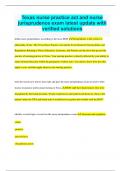Notes de cours
Answers reading questions Comparative Analysis of Political Institutions (CAPI) (USG2051)
- Cours
- Établissement
- Book
All answers of the reading questions as discussed in the seminars week 47 till week 3. The exam has all open questions and many are based on the reading questions. Finished the course with a 8/ A
[Montrer plus]













